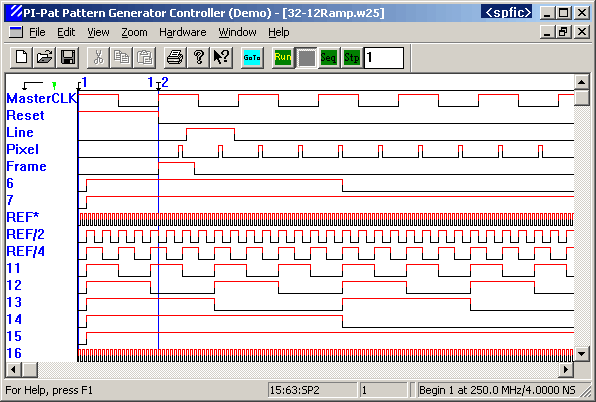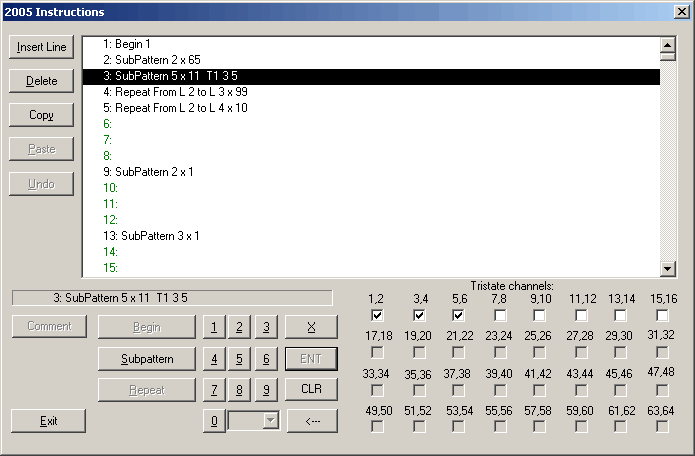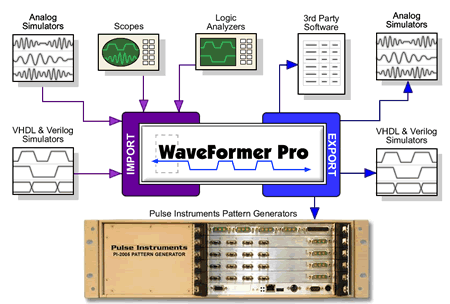| Home | |
| Turnkey Systems | |
| Products | |
|
|
Pattern Generators |
|
|
Clock Drivers |
|
|
|
|
|
Data Acquisition |
|
|
Mainframes |
|
|
Accessories |
| Software | |
| About | |
| Support | |
| News | |
| Contact/Sales | |
| Pulse Research Lab | |
| Top | |
|
PI-2005 Pattern Generator |
|
Products > Pattern Generators |
|
 |
|
Features:
|
Applications:
|
Instrument DescriptionAs a test engineer or digital designer you must have state-of-the-art tools to test, characterize and verify your complex semiconductor devices and digital circuit boards. The PI-2005 Pattern Generator will generate a wide range of simple or complex digital patterns for any test application that requires a serial or parallel digital data stream. To meet the requirements of complex devices and digital circuits, the pattern generator can be configured from 16 to 64 output channels. With almost infinite looping capability and 64 kbits per channel, the PI-2005 can create a digital pattern at speeds and complexities that will fulfill the most demanding requirements. The pattern generator's internal clock provides frequencies from 12 kHz to 225 MHz with a <1% programming accuracy and high stability. The phase locked loop clock gives you high resolution timing for precise placement of the timing signals. The output voltage of the data channels can be either LVTTL- or TTL-compatible, determined by the pattern card selected. Both levels of output are back matched with 50 Ohms to maintain output waveform fidelity. The channel to channel skew for all channels is less than 600 picoseconds. Each channel can be individually programmed to a format of either RZ or NRZ and inverted or non-inverted. Each channel can be individually programmed for tri-state operation. Additionally, the outputs can be tri-stated on the fly in channel pairs. Also, there is an optional delay function that will delay the output channels independently. The maximum programmable delay is 5.8 to 6.6 nanoseconds. Instrument Operation
The 64 kbits of pattern memory are divided into subpatterns that are output according to a set of program instructions. A subpattern can be from 20 bits to 64 kbits long, and the user can define up to 3,276 subpatterns. Once subpatterns are defined, the user populates them with bit patterns.
Program instructions then control the execution sequence, repeating and looping of the subpattern data. This technique of controlling the execution of the data patterns provides virtually unlimited pattern depth. The use of subpatterns and repeats are very useful when the user needs to vary execution time of a test function, such as integration time of an imaging device. Multiple programs can call a common set of subpatterns in a single file, allowing the user to develop timing files for entire families of related devices. The PI-2005 has several other programming features. Although the instrument typically runs in a continuous loop, the user can also program the unit for "Step Mode" or "Cycle Mode". In "Step Mode" the user can specify the execution of 1 to 255 "steps," where a step is the execution of a subpattern one time. In "Cycle Mode" the user may specify the execution of 1 to 255 "cycles," where a cycle is the execution of the program one time. At the end of the defined number of steps or cycles, the instrument will stop and await the next Start signal. The PI-2005 also has a "Start and Stop Trigger" feature. This allows the user to apply an external signal to stop or start the execution of the instruction set. When a stop signal is received the PI-2005 will stop at the end of the subpattern being executed. When the start signal is received the pattern generator will resume execution at the point where it stopped. The PI-2005 also provides an I2C Serial Bus interface for data and clock. Operating ModesThe PI-2005 can operate in Remote-mode or as a standalone instrument. In Remote-mode, the PI-2005 can be controlled over the optional IEEE-488 (GPIB) interface in the same manner as a PI-5800A or PI-2000, either via Pulse Instruments PI-PAT software or via any standard GPIB controller. As a standalone instrument with the optional monitor, keyboard and mouse, the PI-2005 can be programmed using Pulse Instruments PI-PAT software operating in Windows XP. This provides a user-friendly interface for programming, editing and controlling the Pattern Generator. Additionally, the standalone mode allows the embedded CPU of the PI-2005 to operate as a system controller. Software DescriptionPulse Instruments PI-PAT software makes programming the PI-2005 as easy as drawing timing patterns. A large graphical display simplifies data entry and editing functions allowing the user to view and define large segments of the data pattern. Easy to use tools allow the user to quickly check, using a cursor, timing alignment of all critical patterns. Simple ‘go to’ function allows the user to move quickly and easily to any place in the data pattern. There are various functions such as cut/copy/paste; data pattern repeats and magnify are all support by the software. Each channel installed in the instrument can be given a mnemonic signal name. The user and the software then use these names to identify the output channels. The use of mnemonic names for the signals makes the process more intuitive, convenient and easier to recall how each output channel is defined at a later time. PI-PAT provides the entry point to set up the pattern sequencing, repeats and nested looping. The channel formats, delays, clock frequency and tri-stating are all set up within PI-PAT using the various set up pages. PI-PAT runs under Window NT 4.0 (installed on the instrument), but the PI-2005 can also be integrated into non-Windows systems via the GPIB interface. Timing files developed in PI-PAT can be exported as ASCII text commands that can be sent to the instrument via GPIB from any platform or OS that supports GPIB. For detailed information about using the PI-2005 in your application, please download the PI-2005 Operators Manual (2.2 MB .pdf). In addition to complete operating instructions, it also contains a brief tutorial, a special appendix on tri-state-on-the-fly, and a GPIB command set reference guide. This manual requires the freely available Adobe® Acrobat Reader. The PI-2005 Pattern Generator uses the PC-based modular instrumentation platform, CompactPCI ®, which is revolutionizing the test and measurement industry. CompactPCI ®combines the mainstream PC technology and rugged Eurocard packaging to create a high performance, low cost platform for test instrumentation. Because of its small size the PI-2005 can be used in portable, bench and rack mount applications. In particular, it is well suited for production test applications where manufacturing floor space is always at a premium. Import Stimulus from VHDL and Verilog SimulatorsSynaptiCAD's WaveFormer Pro and TestBencher Pro software packages generate stimulus files for the Pulse Instruments PI-2005 Pattern Generator. These products reduce the labor of programming the pattern generator by reusing stimulus created during simulation. Both ship with a built-in timing diagram editor that can draw waveforms from scratch or modify imported waveforms. TestBencher supports repeat loop markers that will cause a section of the waveform data to be repeated by the Pattern Generator. Stimulus vectors used in design and simulation can now be used in production test with the PI-2005. See SynaptiCAD's website for information on using WaveFormer and TestBencher with the PI-2005.
Compatibility:The PI-2005 was designed to be a backward-compatible "drop-in" replacement for the hundreds of PI-5800A and PI-2000 Pattern Generators used every day in test systems throughout the CCD and IR industry. The PI-2005 uses the same core GPIB command set and reads pattern files written for the PI-5800A and PI-2000. If you have detailed application questions about upgrading your PI-5800A or PI-2000 to a PI-2005, please call the factory or email tech support. Our fully-documented command set also makes it simple to integrate the PI-2005 into any system that supports GPIB. |
|
PI-PAT | Specifications | Ordering | Pattern Cards | Datasheet |
|


